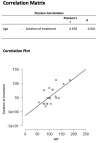Paediatric hip ultrasound: uncertainties in examination and choice of treatment
- PMID: 33643457
- PMCID: PMC7907771
- DOI: 10.1302/1863-2548.15.200084
Paediatric hip ultrasound: uncertainties in examination and choice of treatment
Abstract
Purpose: In Germany, neonates undergo hip sonography examination using the Graf method during the routine U3 screening examination, performed by consultant physicians four to five weeks after birth, and are referred to specialized orthopaedic departments if there are any uncertainties. This study evaluated the quality of sonographic screening in the outpatient sector and the treatment requirements of referred children.
Methods: We performed a retrospective analysis of the patient data of 384 neonates collected in consultations performed between April 2016 and April 2019.
Results: In total, 74% (n = 284) of neonates presented a hip type Ia/b. Treatment (abduction brace or Fettweis cast) was required in 32% (n = 122) of cases. The treatment duration was significantly correlated with age at first presentation (Pearson's r = 0.678; p = 0.001). The treatment duration for patients aged > 200 days old at first presentation was twice as long as those aged 100 days at first presentation. Patients with public health insurance require referral by a consultant. Developmental dysplasia of the hip as referral diagnosis could not be confirmed in control examination in 64% (n = 132) of cases. Of the public health insured children, 97% (n = 200) were referred through a consultant paediatrician.
Conclusion: We identified deficits in performing and interpreting the Graf method of ultrasound examination. A total of 64% of referred pathological hips turned out to be physiological configurations in our control examination. The future goal should be to increase anatomical knowledge of the newborn hip and ensure the correct use of Graf ultrasound method. Advanced training courses are recommended and necessary.
Level of evidence: IV.
Keywords: developmental dysplasia of the hip; neonates; quality control; screening; ultrasound.
Copyright © 2021, The author(s).
Figures
Similar articles
-
Clicky hip alone is not a true risk factor for developmental dysplasia of the hip.Bone Joint J. 2017 Nov;99-B(11):1533-1536. doi: 10.1302/0301-620X.99B11.BJJ-2017-0416.R1. Bone Joint J. 2017. PMID: 29092995
-
[Do German-speaking paediatric orthopaedic surgeons agree on diagnostics and treatment of the neonatal hip?].Z Orthop Unfall. 2012 Apr;150(2):170-6. doi: 10.1055/s-0031-1298345. Epub 2012 Apr 12. Z Orthop Unfall. 2012. PMID: 22498841 German.
-
Disparity between Clinical and Ultrasound Examinations in Neonatal Hip Screening.Clin Orthop Surg. 2016 Jun;8(2):203-9. doi: 10.4055/cios.2016.8.2.203. Epub 2016 May 10. Clin Orthop Surg. 2016. PMID: 27247747 Free PMC article.
-
Cochrane Review: Screening programmes for developmental dysplasia of the hip in newborn infants.Evid Based Child Health. 2013 Jan;8(1):11-54. doi: 10.1002/ebch.1891. Evid Based Child Health. 2013. PMID: 23878122 Review.
-
Common questions about developmental dysplasia of the hip.Am Fam Physician. 2014 Dec 15;90(12):843-50. Am Fam Physician. 2014. PMID: 25591184 Review.
Cited by
-
Fifty percent of patients undergoing periacetabular osteotomy for hip dysplasia showed normal findings upon neonatal ultrasound screening : Symptomatic hip dysplasia in adulthood despite inconspicuous neonatal hip ultrasound.Orthopadie (Heidelb). 2023 Apr;52(4):313-319. doi: 10.1007/s00132-023-04357-7. Epub 2023 Mar 17. Orthopadie (Heidelb). 2023. PMID: 36930261 Free PMC article.
References
-
- Rosendahl K, Markestad T, Lie RT. Developmental dysplasia of the hip: prevalence based on ultrasound diagnosis. Pediatr Radiol 1996;26:635-639. - PubMed
-
- Ihme N, Altenhofen L, von Kries R, et al. . Hip ultrasound screening in Germany. Results and comparison with other screening procedures. Orthopade 2008;37:541-549. - PubMed
-
- Schmitz MR, Blumberg TJ, Nelson SE, Sees JP, Sankar WN. What’s new in pediatric hip? J Pediatr Orthop 2018;38:e300-e304. - PubMed
-
- Swarup I, Penny CL, Dodwell ER. Developmental dysplasia of the hip: an update on diagnosis and management from birth to 6 months. Curr Opin Pediatr 2018;30:84-92. - PubMed
LinkOut - more resources
Full Text Sources
Other Literature Sources
Research Materials
Miscellaneous




